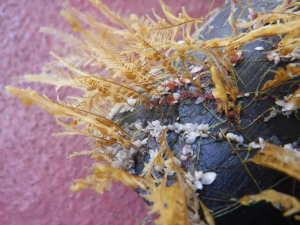
Coastal hydroid and gooseneck barnacles living on floating plastic collected in the North Pacific Subtropical Gyre.
Plastic pollution is creating mobile habitats for species once confined to the coasts.
It used to be that coastal species lived in coastal habitats. This makes sense. But now, a new study describes a surprising number of coastal marine invertebrate species thriving in floating communities in deep ocean waters. What’s their secret? They are colonizing ever-expanding rafts of plastic debris.
The study was led by researchers from the Smithsonian Environmental Research Center (SERC) and the University of Hawai‘i (UH) at Mānoa. They found a diverse range of taxonomic groups of coastal species in the eastern North Pacific Subtropical Gyre on over 70 percent of the plastic debris they examined. Not only that, but the debris carried more coastal species than open ocean species.
